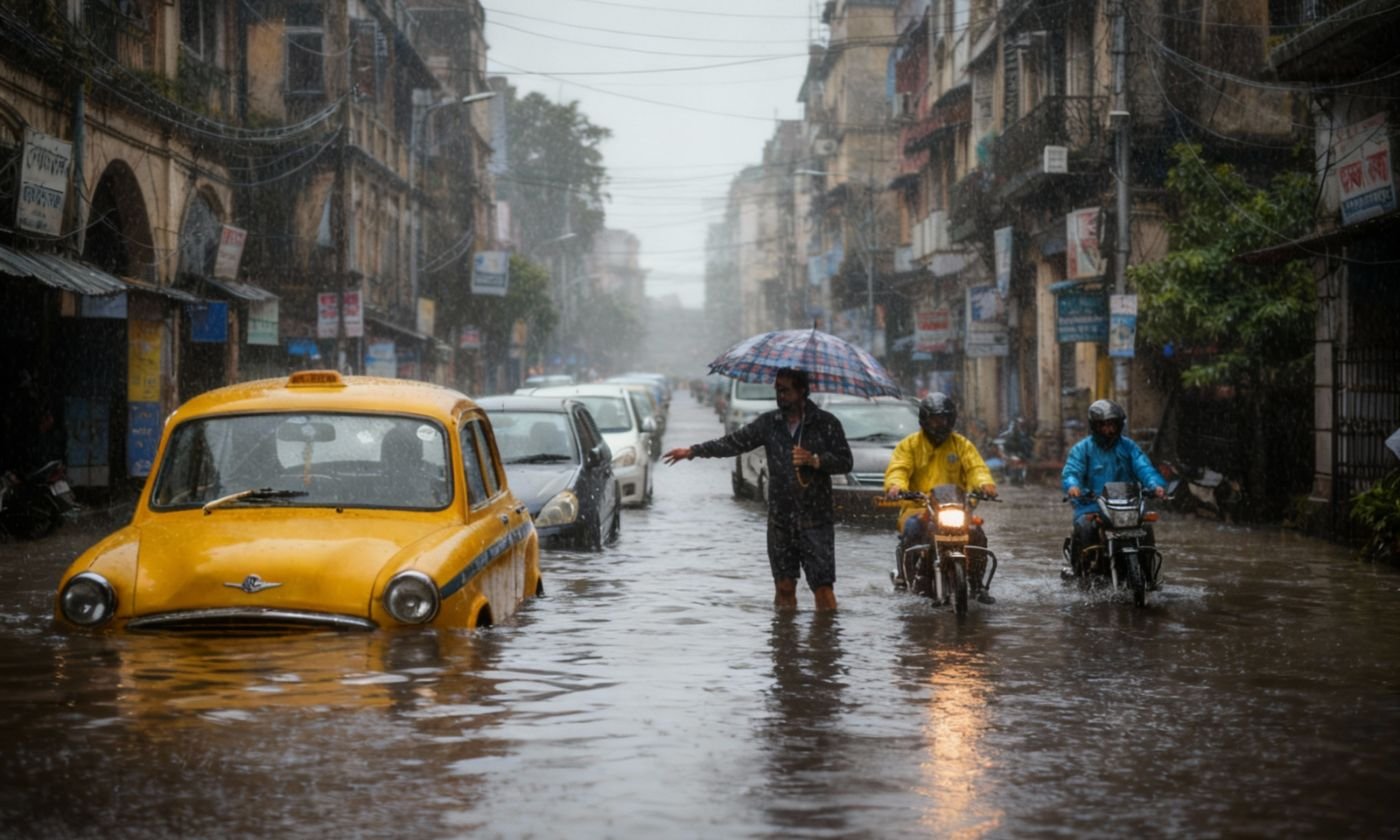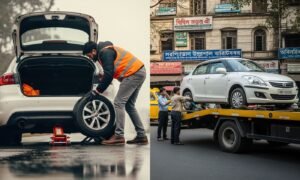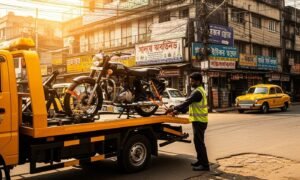November 9, 2025
Kolkata Drenched in Minutes: How to Save Your Car or Bike During a Cloudburst

When the skies opened up over Kolkata in September 2025, the city witnessed hours of relentless downpour that flooded streets, stranded vehicles, and tested every driver’s patience.
The city received some of its highest rainfall in decades. Specifically, on September 23, 2025, Kolkata recorded a phenomenal 251.4 mm of rainfall in 24 hours, making it the third-wettest September day since 1978. This heavy spell was triggered by a low-pressure system over the Bay of Bengal, and one area, Garia Kamdahari, even reported a massive 332 mm of rain. The deluge caused widespread waterlogging that paralyzed normal life, resulting in tragic deaths, mostly due to electrocution, and the cancellation or delay of over 90 flights.
A torrential cloudburst doesn’t just disrupt traffic—it can cause serious damage to your car or bike, and even put your safety at risk.
If you’re a vehicle owner in Kolkata, here’s how to stay safe and protect your ride when nature takes over the streets.
What Exactly Is a Cloudburst?
A cloudburst is an extreme rainfall event — usually more than 100 mm per hour — concentrated over a small area. In a city like Kolkata, where drains overflow quickly, it causes flash floods within minutes.The impact?
Waterlogged roads, traffic chaos, and vehicles left stranded in knee-deep water.
When a heavy cloudburst hits Kolkata, the risks to your vehicle and safety increase dramatically. Follow these critical steps if you are driving:
1. Slow Down, Stay Visible, and Plan Your Route
- Switch on your headlights (low beam) immediately. Use hazard lights only if you are stopped on the side of the road or moving very slowly (below 25 km/h).
- Reduce your speed drastically. Torrential rain causes visibility to plummet and quadruples your braking distance.
- Avoid Known Flood Zones: Steer clear of notorious low-lying areas, such as Topsia, Ultadanga, Behala, and Mukundapur, as they flood earliest and deepest, often trapping vehicles for hours.
2. Never Risk Driving Through Deep Water
- Gauge the Depth: If you cannot see the road divider, or if the water reaches halfway up your tire, DO NOT PROCEED. Just six inches (15 cm) of standing water can stall your engine, and one foot (30 cm) can cause a small car to float and lose control.
- Risk of Hydrolock: Driving through deep water can cause the engine to suck water into the cylinders, leading to hydrostatic lock (hydrolock). This bends the connecting rods and can destroy the engine beyond repair, a very costly mistake that is often not covered by standard insurance.
3. If Your Engine Stalls, Do Not Attempt to Restart
This is the most critical rule to prevent catastrophic engine failure:
- Turn off the ignition immediately (pull the key out).
- DO NOT try to crank the engine again. Attempting to restart a stalled car will suck water further into the engine, guaranteeing hydrolock.
- Secure the Vehicle: Engage the parking brake.
- Call for Towing: Contact a professional towing service or your insurance provider. You must have the vehicle towed to a service center for inspection before attempting to start it.
4. Avoid Low Areas and Underpasses
- Quick Flooding Risk: Underpasses and major low points, like those near Park Circus, Mominpur, and the EM Bypass underpasses, fill up with water very rapidly and become deadly traps.
- Pull Over Safely: If caught near one, choose an elevated route or pull over to a safe, high ground until the downpour subsides.
5. Post-Water Crossing: Dry Your Brakes
- After driving through any standing water, pump your brakes lightly and repeatedly while driving slowly. This friction generates heat, helping to dry the brake pads and discs.
- Wet brakes are unreliable and can cause dangerous skidding.
If You’re Riding a Bike or Scooter
Torrential rain poses extreme dangers for two-wheelers in Kolkata. Balance, grip, and visibility are compromised instantly. Follow these four crucial steps to protect yourself and your ride:
1. Find Safe Shelter and Stop Riding
- Visibility and Grip Collapse: A cloudburst drastically reduces visibility and road grip, making riding highly dangerous. Pull over immediately and activate your hazard lights.
- Choose Wisely: Stop under a permanent structure (like a safe awning or elevated metro/flyover section). Avoid taking shelter under trees (risk of lightning strike/falling branches) or large, old hoardings (risk of collapse).
- Wait it Out: The risk of accidents, skidding, and engine damage is too high. The safest move is to wait for the rain intensity to drop.
2. Walk, Don’t Ride, Through Water
- Do Not Attempt to Ride: Two-wheelers are extremely susceptible to losing balance. Even ankle-deep currents can sweep a bike out from under you.
- Engine Protection: If crossing a shallow, still-water patch is unavoidable, turn the engine off and walk the bike across while keeping the exhaust pipe above the water line. This prevents the high-cost damage of water entering the engine.
- Identify the Bottom: If the water is murky (as it often is in Kolkata), you cannot see open manholes or debris. Extreme caution is required.
3. Post-Soaking Engine and Electrical Check
- If the Engine Stalls: DO NOT attempt to restart the bike immediately. Trying to restart a wet or flooded engine can cause damage by forcing water into sensitive components.
- Wipe Down Key Areas: Once the rain stops, wipe all key electrical areas thoroughly, including the spark plug cap, ignition switch, and battery terminals. Ensure the seat is dry before sitting and riding.
4. Schedule an Immediate Post-Rain Inspection
- Air Filter: Water in the air filter is a common issue that chokes the engine and requires professional drying or replacement.
- Spark Plug and Coil: Ensure these are completely dry to prevent misfiring or ignition failure.
- Brakes: Water reduces braking efficiency. Have your brake pads/shoes and drum/disc mechanisms checked for water saturation and potential rust to restore full braking power.
After the Cloudburst: Your Vehicle Safety Checklist
Once the torrential rain has passed, the period immediately following is critical for minimizing damage and ensuring the future safety of your vehicle.
Immediate Action for Submerged Vehicles (Cars & Bikes)
- Do Not Attempt to Start the Engine: If floodwater reached the engine bay, exhaust pipe, or cabin floor, DO NOT turn the key or press the start button. Attempting to start a water-logged engine will confirm hydrostatic lock (hydrolock), leading to catastrophic and often irreparable engine failure.
- Disconnect the Battery: For safety and to prevent short circuits in the damaged wiring, immediately turn off the ignition and disconnect the negative terminal of the battery.
- Call for Professional Towing: Do not try to drive the vehicle, even if the water has receded. Arrange for the vehicle to be towed directly to a professional service center or a trusted mechanic for assessment.
Post-Water Contamination Maintenance
- Replace Contaminated Fluids: Water contamination severely compromises lubrication. A mechanic must check and replace all affected fluids, including:
- Engine Oil (if milky or cloudy).
- Transmission and Differential Oil (critical for gearbox longevity).
- Replace All Filters: Water renders filters useless. The air filter, oil filter, and fuel filter must be replaced as a standard precaution to prevent rust and debris from entering the system.
- Inspect Electrical Components: Water causes rapid corrosion. Have the mechanic inspect the wiring harness, fuses, relays, and the ECU/ECM (Engine Control Unit) for dampness, mud, or corrosion.
Brakes and Final Safety Check
- Brake System Inspection: Brakes are less efficient after soaking. If the vehicle was driven through water (and did not stall), drive slowly and gently apply the brakes repeatedly to help dry the pads and discs/drums. If the vehicle was submerged, the entire system must be professionally inspected for water ingress and rust.
- Comprehensive Safety Check: Before resuming regular use, ensure a full inspection is completed, focusing on steering components and chassis joints where mud and debris may have settled and could cause future corrosion or mechanical binding.
When in Doubt, Call for Help — Not Luck
Kolkata’s weather is fast and unpredictable. Whether you’re stuck on the waterlogged EM Bypass or stranded in the gridlock of Park Street, relying on luck is insufficient. You need rapid, professional help.
During the record rainfall of September 2025, the City’s Emergency Towing Service received over 800 emergency requests within the initial 12 hours—a fourfold surge. By strategically pre-positioning high-clearance tow vehicles, the team maintained an average response time of under 45 minutes in core affected zones, demonstrating exceptional preparedness.
Our comprehensive support includes:
- 24×7 Emergency Towing and recovery from floodwaters.
- Battery Jump-Starts and roadside electrical assistance.
- On-Site Mechanical Support to minimize delays.
When the streets are submerged, help is near and equipped to reach you quickly.
Final Thoughts
You can’t stop a cloudburst — but you can stay prepared. Keep your fuel tank half full, save emergency contact numbers, and avoid unnecessary drives during heavy rain alerts.
Because when Kolkata gets drenched in minutes, what matters most is staying calm, staying smart, and knowing who to call. And when you contact Ride N Rescue, you’re not just getting a tow — you’re getting peace of mind.
GET IN TOUCH
Related Blog
Similar articles you may like
Roadside Assistance or Towing – Which Service Fits Your Situation?
Imagine you’re driving down the EM Bypass on a busy weekday evening. The traffic is slow, the honking never seems…
What Should You Do When Your Car or Bike Breaks Down on the Road in Kolkata?
A sudden breakdown can turn any journey into a stressful experience. Whether you are driving along Park Street, riding through…
How to Choose the Best Bike Towing Service in Kolkata?
A motorcycle breakdown can be as stressful as a car breakdown – sometimes even more so, since bikes are more…



